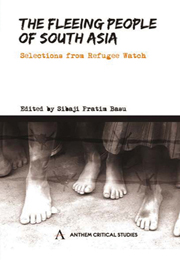Book contents
- Frontmatter
- Contents
- Acronyms and Abbreviations
- Foreword by Ranabir Samaddar
- Preface
- ETHICAL ISSUES
- LAWS
- SOUTH ASIA
- INDIA
- GENDER
- Introduction
- Refugee Repatriation: A Politics of Gender
- Families, Displacement, Partition
- Widows of Brindaban: Memories of Partition
- Agony Continues: Refugee Women of Bhutan
- Dislocating Women and Making the Nation
- Geder, Media and the Tsunami
- Why Should we Listen to Her?
- Women, Trafficking and Statelessness
- The Bar Dancer and the Trafficking Migrant: Globalization and Subaltern Existence
- INTERVIEW/CORRESPONDENCE
- REPRESENTATIONS
- Index
Dislocating Women and Making the Nation
from GENDER
Published online by Cambridge University Press: 05 March 2012
- Frontmatter
- Contents
- Acronyms and Abbreviations
- Foreword by Ranabir Samaddar
- Preface
- ETHICAL ISSUES
- LAWS
- SOUTH ASIA
- INDIA
- GENDER
- Introduction
- Refugee Repatriation: A Politics of Gender
- Families, Displacement, Partition
- Widows of Brindaban: Memories of Partition
- Agony Continues: Refugee Women of Bhutan
- Dislocating Women and Making the Nation
- Geder, Media and the Tsunami
- Why Should we Listen to Her?
- Women, Trafficking and Statelessness
- The Bar Dancer and the Trafficking Migrant: Globalization and Subaltern Existence
- INTERVIEW/CORRESPONDENCE
- REPRESENTATIONS
- Index
Summary
More than 80 per cent of the world's refugee population comprises of women and their dependent children. An overwhelming majority of these women come from the developing world. South Asia is the fourth largest refugee producing region in the world, a majority of whom are women. ‘Refugee women and children form 76 per cent of the total refugee population in Pakistan, 79 per cent in India, 73 per cent in Bangladesh and 87 per cent in Nepal’. The sheer number of women among the refugee population portrays that it is a gender issue. On the basis of examples taken from different refugee experiences in South Asia, this chapter argues that both displacement and asylum are gendered experiences. At least in the context of South Asia it results from and is related to the marginalization of women by the South Asian states. These states at best patronize women and at worse infantilize, disenfranchise and de-politicize them. It is in the person of a refugee that women's marginality reaches its climactic height. By refusing to create a South Asian refugee regime, states in South Asia continue their castigation of non-conforming women to the status of political non-subjects.
STATE FORMATION AND THE QUESTION OF ABDUCTED WOMEN
The Partition of the Indian subcontinent in 1947 witnessed probably the largest refugee movement in modern history. About 8 million Hindus and Sikhs left Pakistan to resettle in India while about 6–7 million Muslims went to Pakistan.
- Type
- Chapter
- Information
- The Fleeing People of South AsiaSelections from Refugee Watch, pp. 320 - 329Publisher: Anthem PressPrint publication year: 2009



